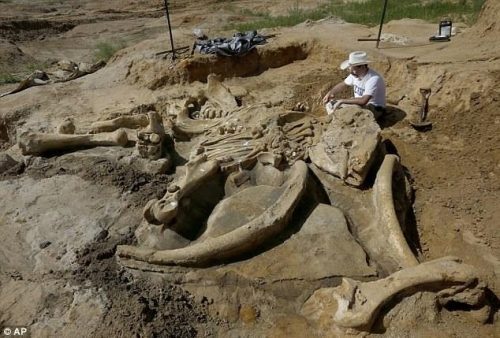In a stunning revelation that has set the scientific community abuzz, a Texan family has unearthed a remarkable 60,000-year-old mammoth fossil on their ranch property.

This extraordinary discovery occurred in May when Marty McEwen and his grandson, Ethan Beasley, were conducting excavation work at their family-owned business in the heart of Texas. The story of this prehistoric encounter has not only captivated the local community but has also gained global attention.
The journey leading to this remarkable discovery began when Mr. McEwen’s excavator struck a massive six-foot (1.8-meter) mammoth tusk buried beneath the Texan soil. Recognizing the historical significance of their find, McEwen and Beasley promptly contacted paleontologists who specialize in unearthing ancient treasures, especially in the context of Texas’ rich paleontological history.

The mammoth’s skeletal remains, despite being eons old, are exceptionally well-preserved. The recovered pieces include the skull, ribs, and lower jaw, providing a rare and comprehensive glimpse into the anatomy of these ancient giants. However, it’s worth noting that some leg bones were notably absent, leaving questions about the circumstances of the mammoth’s demise.
Dr. Vance, the paleontologist overseeing the excavation site, has underlined the immense importance of this discovery. He highlights the potential of this mammoth find to provide invaluable insights into North Central Texas’ prehistoric environment. By examining the geological and environmental context in which this mammoth lived, scientists hope to uncover clues about the climate, vegetation, and ecosystem of that era.

A Mammoth’s Journey Through Time
This mammoth, estimated to be between 20,000 and 60,000 years old, belongs to the Pleistocene epoch. During this period, these colossal creatures roamed the Earth, coexisting with various other megafauna species. The mammoth was closely related to modern-day elephants, sharing similarities in their appearance, behavior, and ecological roles. In its prime, this mammoth would have been a formidable herbivore, exerting a significant influence on its prehistoric ecosystem.
The Pleistocene epoch was characterized by multiple ice ages and interglacial periods. The discovery of a mammoth of this age is a rare find indeed, as it allows scientists to delve into the environmental conditions and life during these periods. Researching such ancient remains contributes to our understanding of climatic changes, megafaunal extinctions, and the adaptations of prehistoric life to changing environments.

Protecting the Precious Find
To protect this invaluable fossil, the McEwen family decided not to disclose the exact location of the excavation site. This discretion ensures the preservation of the mammoth’s remains and allows for continued scientific study without the risks associated with uncontrolled access.

The discovery of a 60,000-year-old mammoth fossil on a Texan ranch is not just a testament to the mysteries hidden beneath the Earth’s surface but a celebration of the curiosity and perseverance of the McEwen family. This remarkable find has the potential to unlock the secrets of a bygone era, offering insights into the ancient past that continues to shape our understanding of the world today.





